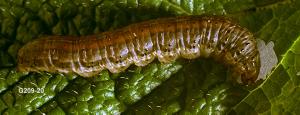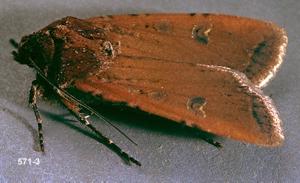|
REDBACKED CUTWORM LIFE CYCLE AND BIOLOGY |
|||||
CONTENTS |
Redbacked cutworm, Euxoa ochrogaster, and a complex of other Euxoa species (E. olivia, E. messoria, E. infracta, E. septentrionalis, and E. recula) feed on mint and other crops East of the Cascade Mountains. These other cutworm species occur at about the same time as the redbacked cutworm, but they have different life cycles and the larval feeding damage overlaps among the different species from March through June.
Redbacked cutworm overwinters in the soil as eggs or small
larvae. Eggs hatch in March and April as soil temperatures increase. Larvae feed on mint
roots beneath the soil surface by day and/or on foliage during the night. Individual
larvae feed for 5 to 8 weeks. Most of the damage occurs in late April, May and early June.
When mature, the larvae pupate in earthen cells in the soil. |



